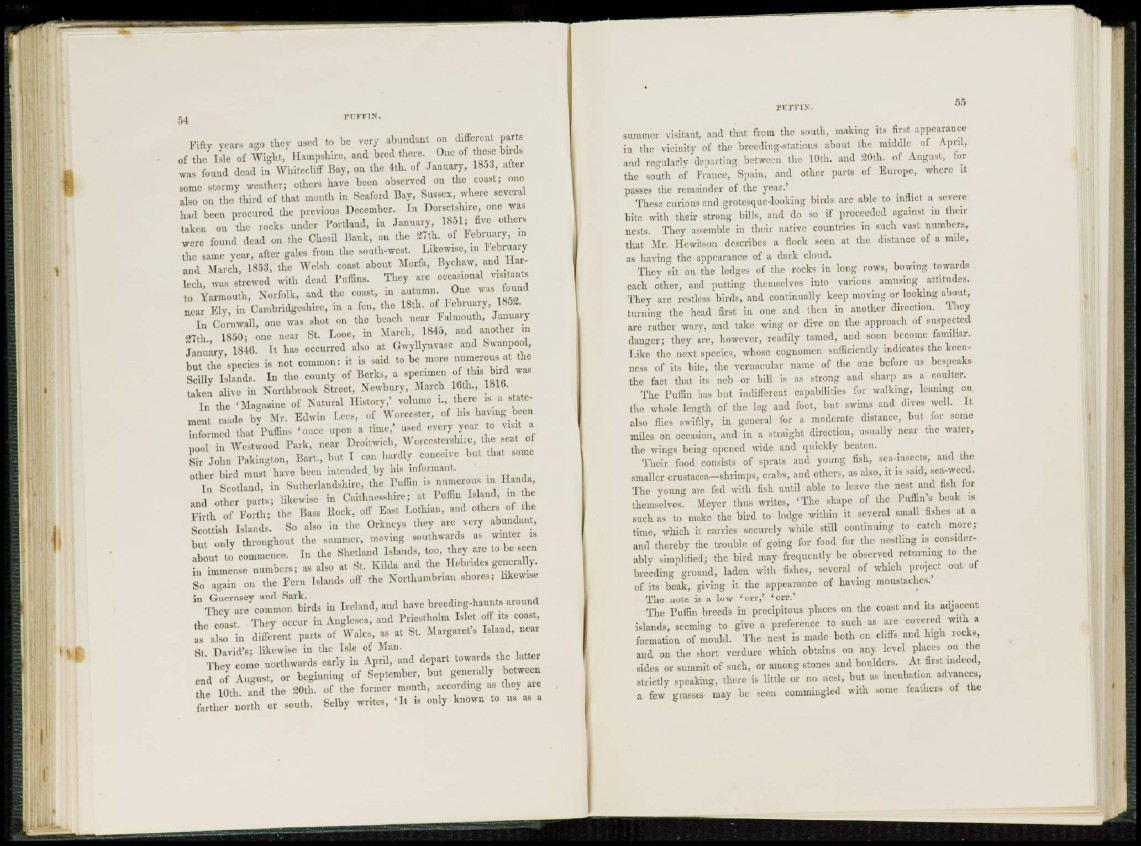
54 FT'FFIN.
Fifty years ago they used to be very abundant on different parts
of the Isle of Wight, Hampshire, and bred there. One of these birds
was found dead in White cliff Bay, on the 4th. of January, 1853, after
some stormy weather; others have been observed on the coast; one
also on the third of that month in Seaford Bay, Sussex, where several
had been procured the previous December. In Dorsetshire, one was
taken on the rocks under Portland, in January, 1851; five others
were found dead on the Chesil Bank, on the 27th. of February, in
the same year, after gales from the south-west. Likewise, in February
and March, 1853, the Welsh coast about Morfa, Bychaw, and Harlech,
was strewed with dead Puffins. They are occasional visitants
t o Yarmouth, Norfolk, and the coast, in autumn. One was found
near Ely, in Cambridgeshire, in a fen, the 18th. of February, 1853.
I n Cornwall, one was shot on the beach near Falmouth, January
27th., 1850; one near St. Looe, in March, 1845, and another in
January, 1816. Tt has occurred also at Gwyllynvase and Swanpool,
but the species is not common: it is said to be more numerous at the
Scilly Islands. In the county of Berks, a specimen of this bird was
taken alive in Northbrook Street, Newbury, March 16th., 1816.
I n the 'Magazine of Natural History,' volume i., there is a statement
made by Mr. Edwin Lees, of Worcester, of his having been
informed that Puffins 'once upon a time,' used every year to visil a.
pool in Westwood Park, near Droitwich, Worcestershire, the seat of
Sir John Pakington, Bart., but I can hardly conceive but that some
other bird must have been intended by his informant.
I n Scotland, in Sulherlandshire, the Puffin is numerous in Handa,
and other parts; likewise in Cailhnesshire; at Puffin Island, in the
F i r t h of Forth; the Bass Bock, off East Lothian, and others of the
Scottish Islands. So also in the Orkneys they are very abundant,
but only throughout the summer, moving southwards as winter is
about to commence. In the Shetland Islands, too, they are to be seen
in immense numbers; as also at St. Kilda and the Hebrides generally.
So again on the Fern Islands off the Northumbrian shores; likewise
in Guernsey and Sark.
They are common birds in Ireland, and have breeding-haunts around
the coast. They occur in Anglesca, and Priestholm Islet off its coast,
as also in different parts of Wales, as at St. Margaret's Island, near
St. David's; likewise in the Isle of Man.
They come northwards early in April, and depart towards the latter
end of August, or beginning of September, but generally between
t h e 10th. and the 20th. of the former month, according as they are
farther north or south. Selby writes, ' I t is only known to us as a
summer visitant, and that from the south, making its first appearance
in the vicinity of the breeding-stations about the middle of April,
and regularly departing between the 10th. and 20th. of August, for
the south of France, Spain, and other parts of Europe, where it
passes the remainder of the year.'
These curious and grotesque-looking birds arc able to inflict a severe
bite with their strong bills, and do so if proceeded against in their
nests. They assemble in their native countries in such vast numbers,
that Mr. Hewitson describes a flock seen at the distance of a mile,
as having the appearance of a dark cloud.
They sit on the ledges of the rocks in long rows, bowing towards
each other, and putting themselves into various amusing attitudes.
They are restless birds, and continually keep moving or looking about,
turning the head first in one and then in another direction. They
are rather wary, and take wing or dive on the approach of suspected
danger; they are, however, readily tamed, and soon become familiar.
Like the next species, whose cognomen sufficiently indicates the keenness
of its bite, the vernacular name of the one before us bespeaks
the fact that its neb or bill is as strong and sharp as a coulter.
The Puffin has but indifferent capabilities for walking, leaning on
the whole length of the leg and foot, but swims and dives well. It
also flies swiftly, in general for a moderate distance, but for some
miles on occasion, and in a straight direction, usually near the water,
the wings being opened wide and quickly beaten.
Their food consists of sprats and young fish, sea-insects, and the
smaller Crustacea—shrimps, erabs, and others, as also, it is said, sea-weed.
The young are fed with fish until able to leave the nest and fish for
themselves. Meyer thus writes, ' T h e shape of the Puffin's beak is
such as to make the bird to lodge within it several small fishes at a
time, which it carries securely while still continuing to catch more;
and thereby the trouble of going for food for the nestling is considerably
simplified; the bird may frequently be observed returning to the
breeding ground, laden with fishes, several of which project out of
of its beak, giving it the appearance of having moustaches.'
The note is a low ' o r r , ' ' o r r .'
The Puffin breeds in precipitous places on the coast and its adjacent
islands, seeming to give a preference to such as are covered with a
formation of mould. The nest is made both on cliffs and high rocks,
and on the short verdure which obtains on any level places on the
sides or summit of such, or among stones and boulders. At first indeed,
strictly speaking, there is little or no nest, but as incubation advances,
a few grasses may be &eeu commingled with some feathers of the